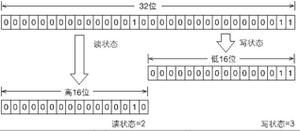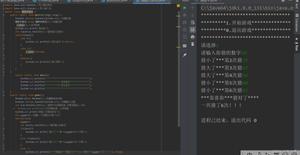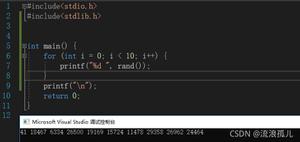多线程random_r比单线程版本慢
以下程序与此处描述的程序基本相同。当我使用两个线程(NTHREADS== 2)运行并编译程序时,得到以下运行时间:
real 0m14.120suser 0m25.570s
sys 0m0.050s
当仅使用一个线程(NTHREADS == 1)运行时,即使仅使用一个内核,运行时间也会明显缩短。
real 0m4.705suser 0m4.660s
sys 0m0.010s
我的系统是双核的,我知道random_r是线程安全的,并且我很确定它是非阻塞的。如果在没有random_r的情况下运行同一程序,并且使用余弦和正弦值的计算作为替换,则双线程版本的运行时间约为预期的1/2。
#include <pthread.h>#include <stdlib.h>
#include <stdio.h>
#define NTHREADS 2
#define PRNG_BUFSZ 8
#define ITERATIONS 1000000000
void* thread_run(void* arg) {
int r1, i, totalIterations = ITERATIONS / NTHREADS;
for (i = 0; i < totalIterations; i++){
random_r((struct random_data*)arg, &r1);
}
printf("%i\n", r1);
}
int main(int argc, char** argv) {
struct random_data* rand_states = (struct random_data*)calloc(NTHREADS, sizeof(struct random_data));
char* rand_statebufs = (char*)calloc(NTHREADS, PRNG_BUFSZ);
pthread_t* thread_ids;
int t = 0;
thread_ids = (pthread_t*)calloc(NTHREADS, sizeof(pthread_t));
/* create threads */
for (t = 0; t < NTHREADS; t++) {
initstate_r(random(), &rand_statebufs[t], PRNG_BUFSZ, &rand_states[t]);
pthread_create(&thread_ids[t], NULL, &thread_run, &rand_states[t]);
}
for (t = 0; t < NTHREADS; t++) {
pthread_join(thread_ids[t], NULL);
}
free(thread_ids);
free(rand_states);
free(rand_statebufs);
}
我很困惑,为什么在生成随机数时两个线程版本的性能比单线程版本差很多,因为考虑将random_r用于多线程应用程序。
回答:
一个非常简单的更改以将数据分配到内存中:
struct random_data* rand_states = (struct random_data*)calloc(NTHREADS * 64, sizeof(struct random_data));char* rand_statebufs = (char*)calloc(NTHREADS*64, PRNG_BUFSZ);
pthread_t* thread_ids;
int t = 0;
thread_ids = (pthread_t*)calloc(NTHREADS, sizeof(pthread_t));
/* create threads */
for (t = 0; t < NTHREADS; t++) {
initstate_r(random(), &rand_statebufs[t*64], PRNG_BUFSZ, &rand_states[t*64]);
pthread_create(&thread_ids[t], NULL, &thread_run, &rand_states[t*64]);
}
导致我的双核计算机上的运行时间大大缩短。
这将证实它要测试的怀疑-您正在两个单独的线程中对同一高速缓存行中的值进行突变,因此具有高速缓存争用。赫伯·萨特(Herb Sutter)的“机器体系结构-您的编程语言从未告诉过您的话题”值得一看,如果您还有时间不知道的话,他演示了从1:20左右开始的虚假共享。
计算您的缓存行大小,并创建每个线程的数据,使其与之对齐。
将线程的所有数据整理到一个结构中,然后对齐它会更干净一些:
#define CACHE_LINE_SIZE 64struct thread_data {
struct random_data random_data;
char statebuf[PRNG_BUFSZ];
char padding[CACHE_LINE_SIZE - sizeof ( struct random_data )-PRNG_BUFSZ];
};
int main ( int argc, char** argv )
{
printf ( "%zd\n", sizeof ( struct thread_data ) );
void* apointer;
if ( posix_memalign ( &apointer, sizeof ( struct thread_data ), NTHREADS * sizeof ( struct thread_data ) ) )
exit ( 1 );
struct thread_data* thread_states = apointer;
memset ( apointer, 0, NTHREADS * sizeof ( struct thread_data ) );
pthread_t* thread_ids;
int t = 0;
thread_ids = ( pthread_t* ) calloc ( NTHREADS, sizeof ( pthread_t ) );
/* create threads */
for ( t = 0; t < NTHREADS; t++ ) {
initstate_r ( random(), thread_states[t].statebuf, PRNG_BUFSZ, &thread_states[t].random_data );
pthread_create ( &thread_ids[t], NULL, &thread_run, &thread_states[t].random_data );
}
for ( t = 0; t < NTHREADS; t++ ) {
pthread_join ( thread_ids[t], NULL );
}
free ( thread_ids );
free ( thread_states );
}
与CACHE_LINE_SIZE64:
refugio:$ gcc -O3 -o bin/nixuz_random_r src/nixuz_random_r.c -lpthreadrefugio:$ time bin/nixuz_random_r
64
63499495
944240966
real 0m1.278s
user 0m2.540s
sys 0m0.000s
或者,您可以使用两倍的缓存行大小,并使用malloc-额外的填充可确保变异的内存位于单独的行上,因为malloc为16(IIRC),而不是64字节对齐。
(我将ITERATIONS减少了十倍,而不是拥有笨拙的机器)
以上是 多线程random_r比单线程版本慢 的全部内容, 来源链接: utcz.com/qa/409213.html









